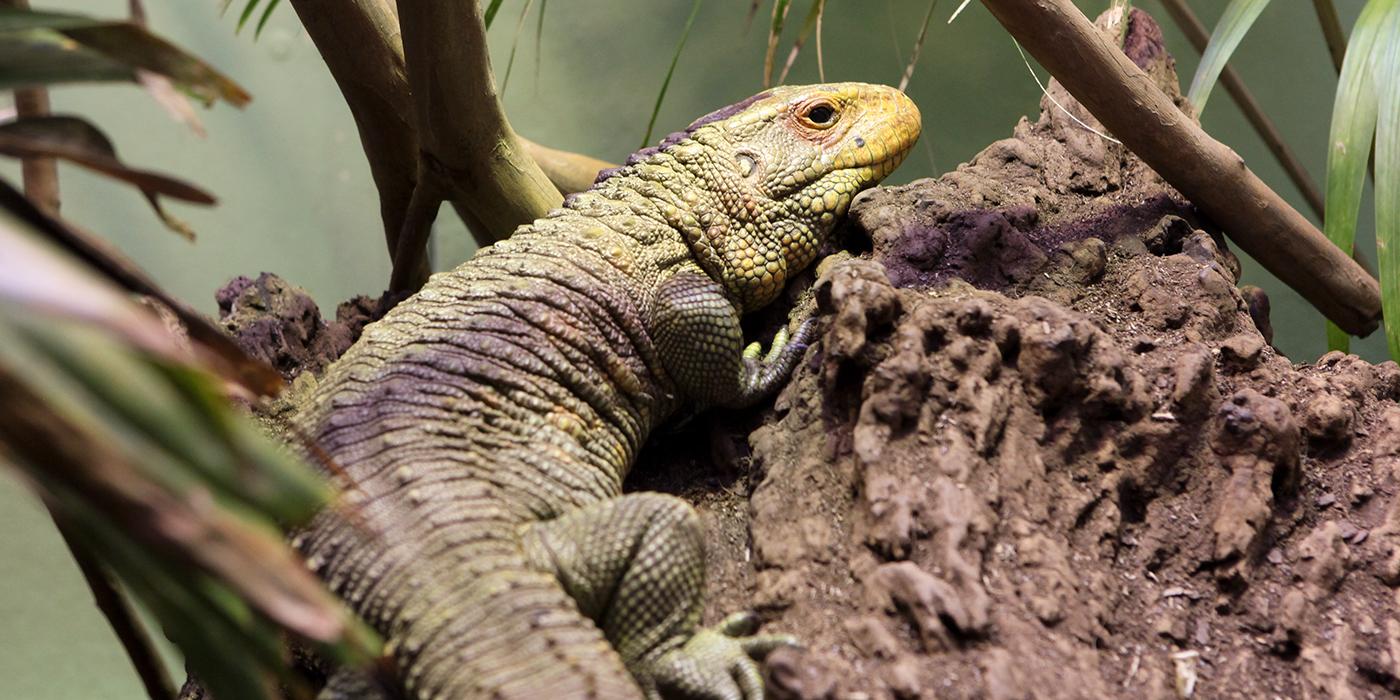Physical Description
The caiman lizard is a large reptile with a green body and reddish-orange head. It has a long, laterally flattened tail and raised, horn-like scales along its back that offer some protection from predators. This lizard has a forked tongue for locating prey and powerful jaws with short, rounded teeth.
This semiaquatic species spends part of its time in the water. A third, clear eyelid acts like a goggle when submerged. Caiman lizards are also excellent climbers. When threatened, they often choose flight over fight, dropping into the water to swim away. They can, however, whip their tails around and bite at would-be predators.
Size
This large lizard varies in length from .6 to 1.3 meters (2 to 4 feet) and can weigh up to 4.5 kilograms (10 pounds).
Native Habitat
Caiman lizards are found in Ecuador, Colombia, Brazil, Peru, and the Guianas. They live in swampy habitats or other flooded woodlands, where they spend most of their time basking on low branches and roots overhanging marshes, flooded forests and streams. This allows them to make a quick escape from sudden danger by dropping into the water.
Jaguars, snakes and crocodiles prey on these large lizards, but they have few other predators in the wild. Their ability to both climb and swim helps them to avoid danger.
Food/Eating Habits
The carnivorous caiman lizard feeds primarily on invertebrates, such as snails, crawfish and freshwater clams. They are also known predators of Amazon river turtles. Once a prey item is caught, the lizard raises its head, moving the meal into position at the back of its powerful jaws. Then, it crushes the animal with its strong back teeth, spits out the broken shell and consumes the softer part of its prey.
At the Smithsonian's National Zoo, caiman lizards eat mealworms, omnivore diet, snails and crawfish.
Sleep Habits
These semiaquatic lizards forage during the day, hiding in trees and bushes at night. Most of their time is spent in the water or basking on branches.
Reproduction and Development
Little is known about the reproductive behavior and cycle of the caiman lizard. This species reproduces sexually, and females lay five to seven fertilized eggs per clutch, with an incubation period of about 179 days. They lay their eggs in holes in the riverbank, which they then cover. Hatchlings are born independent, requiring no prenatal care.
Conservation Efforts
The caiman lizard was once widely hunted for its leather, but in the 1970s, regulations were passed to control hunting for the leather trade. Since then, wild populations have been able to recover. In its place, farms now raise caiman lizards to supply the demand for their leather.
Though hunting has decreased, other complex issues affect local populations. Pollution, deforestation and habitat loss in certain areas of its range likely impact this species, as it depends on forested and aquatic environments that are often subject to these human pressures.
Local, indigenous people also hunt caiman lizards for their meat. This practice may not be a significant threat to the wild population, but research is needed to determine whether hunting practices are sustainable for the caiman lizard's local populations, as well as to understand this animal's status in the wild and its response to anthropogenic change.
Help this Species
Reduce, reuse and recycle — in that order! Cut back on single-use goods, and find creative ways to reuse products at the end of their life cycle. Choose recycling over trash when possible.
Be a smart consumer! Avoid animal-skin products, even those marked “faux,” to ensure you’re not contributing to the illegal hunting of this species.
Smithsonian's National Zoo and Conservation Biology Institute. (n.d.). Caiman lizard. Retrieved January 2, 2026, from https://nationalzoo.si.edu/animals/caiman-lizard





